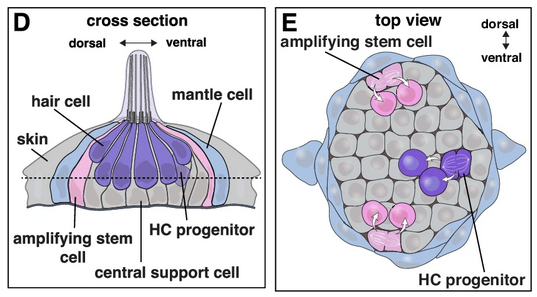By Manoj Kumar, Ph.D.
Given the increasing environmental noise pollution in modern societies, exposure to loud sounds is an ever-growing public health problem. Approximately 40 million adults in the U.S. have symptoms of noise-induced hearing loss (NIHL). Moreover, NIHL is the leading cause of highly prevalent disorders, such as tinnitus (ringing in the ears) and hyperacusis (noise-induced discomfort or pain), with an overall economic impact of $150 billion in the U.S.
Because of the growing number of individuals with NIHL and hearing loss–related disorders, the need to advance the development of treatment options is imperative and vastly dependent on understanding the circuit, synaptic, and intrinsic mechanisms of central plasticity after NIHL. In this study, we identified the cell-type specific plasticity among different subtypes of inhibitory neurons (IN) in the mouse auditory cortex after NIHL. We published our findings in Nature Communications in July 2023.
Data collected from brain cells before and after noise exposure. Click here for more details. Credit: Kumar et al./Nature Communications
In the auditory system, while the auditory nerve input to the brainstem is significantly reduced after cochlear damage caused by loud noise or ototoxic compounds (medications harmful to hearing), cortical sound–evoked activity is maintained or even enhanced.
To study the precise mechanisms of inhibition in the recovery of cortical sound-evoked activity after hearing loss, we used a mouse model of NIHL. We used two-photon calcium imaging to study sound-evoked activity in different types of cortical neurons in awake mice. Additionally, we conducted ex vivo electrophysiology assays to assess cellular excitability in these neurons. To support our findings, we employed computational models to develop hypotheses and predictions.
After NIHL, we noticed that certain brain cells called excitatory principal neurons (PNs), parvalbumin-expressing neurons (PVs), and vasoactive intestinal peptide-expressing neurons (VIPs) had their sound-evoked activity restored. However, another type of cell, known as somatostatin-expressing neurons (SOMs), had reduced activity. This change in activity was unique to each type of cell and was related to their individual ability to change and adapt (intrinsic plasticity).
Our study is the first to identify the cell-type–specific plasticity of the different cortical IN subtypes in cortical recovery after noise trauma, and it suggests distinct roles for these interneurons in this process.
As such, these results highlight a strategic, cooperative, and cell-type–specific plasticity program that may contribute to restoring cortical sound processing after cochlear damage. This may provide novel cellular targets that may aid in the development of pharmacotherapeutic or rehabilitative treatment options for impaired hearing after NIHL.
For example, SOMs, which are critically important for the temporal processing of sounds, showed reduced sound-evoked activity after NIHL. We propose that the reduced SOM activity after NIHL may contribute to the hearing problems associated with NIHL, such as difficulty in understanding speech and trouble hearing in noisy environments. Therefore, SOMs could be a potential neuronal target to rehabilitate hearing after NIHL.
Overall, our results create a new framework for understanding the cellular and circuit mechanisms underlying brain plasticity after hearing loss and hold the promise to advance understanding of the cortical mechanisms underlying disorders associated with maladaptive cortical plasticity after peripheral damage, such as tinnitus, hyperacusis, and difficulty hearing in noisy environments.
Manoj Kumar, Ph.D., is a research assistant professor in the department of otolaryngology at the University of Pittsburgh School of Medicine. His 2022 Emerging Research Grant, renewed for a second year in 2023, is generously funded by Royal Arch Research Assistance.
To learn more, please see the press release from Pitt’s Eye and Ear Institute, where Kumar notes that the study’s results may also be able to help other conditions that result from dysfunctional brain changes, such as visual hallucinations and phantom limb pain.









Before I discovered CART, I often felt left out, despite being physically present. This gap in awareness affects thousands of people. That’s why I speak up, because access delayed is opportunity denied.